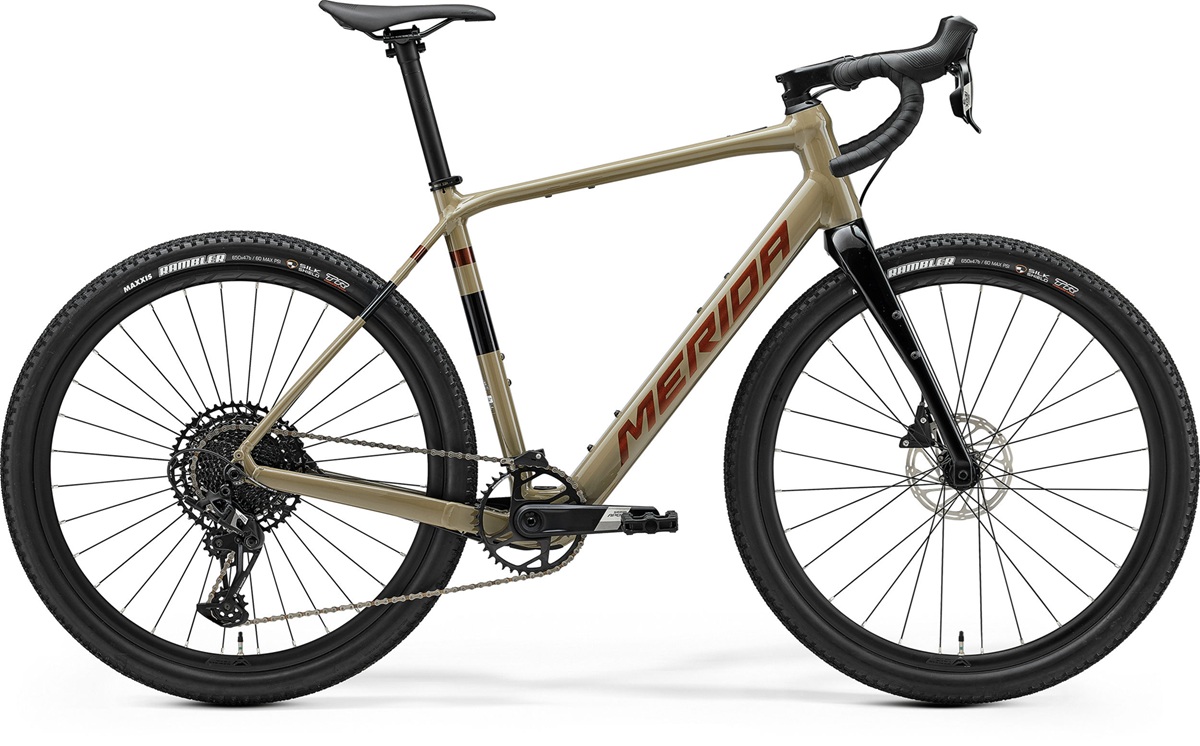
MERIDA eSILEX+ 600 2025 E-bike: Test, Review, Pros, Cons, Issues, Performance, Opinions, Everything You Really Need to Know
MERIDA eSILEX+ 600 2025 E-bike: Test, Review, Pros, Cons, Issues, Performance, Opinions, Everything You Really Need to Know
MERIDA eSILEX+ 600 2025 E-Bike: Technical Analysis, Review, and Detailed Test
Pros, Cons, Performance, Range, and Everything You Need to Know
The Merida eSILEX+ 600 2025 is positioned in the light-assist e-Gravel segment. This bicycle is designed to offer discreet support for mixed-surface exploration, light bike-touring, and commuting, maintaining a slim aesthetic closer to that of a non-electric bicycle. The 2025 model continues the established design philosophy, focusing on the reliability of the propulsion system and minimal integration.
MERIDA eSILEX+ 600 2025 Review Test: Construction Quality
The construction quality of the Merida eSILEX+ 600 aligns with Merida's standards for mid-to-high-range aluminum frames.
Production Standards: The frame is made from eSILEX+ LITE II hydroformed aluminum, utilizing triple-butted tubing to balance lightweight design with strength. Attention to detail is evident in the integration of the Mahle electric system.
System Integration: The 250 Wh battery is fully concealed within the downtube, significantly contributing to the sleek, traditional bicycle silhouette. The charging port is functionally placed, typically near the bottom bracket.
Finishing: Welds are visible, as the aluminum frame is not smoothed, but the overall finishing and paintwork are durable, designed to withstand the typical wear and tear of gravel and dirt road use.
MERIDA eSILEX+ 600 2025 Review Test: Frame
The aluminum frame is structured for gravel riding, inheriting characteristics from the non-electric Silex platform.
Material and Design: The eSILEX+ LITE II aluminum frame is optimized to cleanly house the Mahle motor unit and battery.
Geometry: The geometry prioritizes stability and comfort. It features a relatively relaxed head tube angle, and the flat-bar handlebar combined with a short stem (MERIDA EXPERT IR) encourages a slightly more upright riding position. This setup is suitable for long distances and improves control on uneven terrain.
Versatility: The frame includes numerous mounting points on the fork and main triangle, essential for fitting racks, fenders, bikepacking bags, and extra bottle cages, making it highly versatile for touring.
MERIDA eSILEX+ 600 2025 Review Test: Components
The eSILEX+ 600 build is well-balanced for gravel use, prioritizing component reliability.
Drivetrain: The 2025 model is typically equipped with a SRAM Apex Eagle 1x12 groupset (single chainring) with a wide-range cassette (e.g., 10-50 teeth). This gearing is crucial for tackling steep climbs even with minimal or no electric assistance. Some regional variants may feature Shimano GRX 1x11.
Brakes: It uses hydraulic disc brakes, either SRAM Apex or Shimano GRX 600, with 160 mm rotors. Hydraulic braking is necessary for control on dirt roads and managing the e-bike's additional weight.
Fork: The fork is carbon (MERIDA SILEX CF2), rigid and designed to dampen frontal vibrations, which improves riding comfort and shock absorption compared to an aluminum fork.
Wheels and Tires: The eSILEX+ model is often built with 650B (27.5-inch) wheels and high-volume tires, such as the Maxxis Rambler 650Bx47. This combination maximizes traction and cushioning on rough surfaces.
MERIDA eSILEX+ 600 2025 Review Test: Comfort
Comfort is a central element in the eSILEX design philosophy.
Riding Position: The trail-oriented geometry supports a slightly more upright posture, which reduces strain on the neck and back, making it suitable for long days in the saddle and daily commuting.
Vibration Damping: The combination of the aluminum/carbon frame and fork, along with the high-volume 650B tires, ensures effective filtering of vibrations from gravel and uneven asphalt.
MERIDA eSILEX+ 600 2025 Review Test: Ride Experience
The ride experience is defined by the subtle assistance of the Mahle hub motor and the bike's overall low weight for an e-bike.
Handling Characteristics: The bike offers stable, composed, and predictable handling. With a weight around 13.2 kg, the bicycle handles naturally even with the motor turned off, a key advantage of the light-assist system.
Mahle X30/X35 Assistance: The Mahle X30/X35 system (rear hub motor, 40-45 Nm of torque) provides smooth and natural power delivery. It primarily functions as an amplifier of the rider's effort. This system is optimal for countering wind or providing light support on moderate inclines, but it cannot match the raw power of a high-torque mid-drive motor.
Control: The minimalist iWOC control unit, integrated into the top tube, allows switching between assistance levels and monitoring battery status via colored indicators, maintaining a clean cockpit. The Mahle app is used for fine-tuning power levels.
MERIDA eSILEX+ 600 2025 Review Test: Performance and Range
Performance should be understood within the light e-gravel segment context.
Power and Torque: The 40-45 Nm of torque is sufficient for gravel and road use. On very steep and technical off-road climbs, the support may feel limited for riders demanding high power output.
Battery and Range: The integrated 250 Wh battery (approx. 237 Wh effective) is a compromise for low weight and integration, not for maximum range. Range is highly variable: under ideal conditions and low assistance, it may exceed 100 km. However, aggressive motor use will significantly reduce this distance.
Range Extender: For long adventures, purchasing the optional Mahle Range Extender (which mounts like a water bottle, adding 208 Wh or 250 Wh more capacity) is strongly recommended to substantially extend the total range.
MERIDA eSILEX+ 600 2025 Review Test: Pros and Cons
Pros:
Aesthetic Integration: Extremely clean look, visually similar to a traditional bicycle, thanks to the full integration of the hub motor and battery.
Bikepacking Versatility: Abundant mounting points on the frame and fork.
Low Weight: Relatively low weight (around 13.2 kg) ensures good rideability even without power assistance.
Ride Comfort: Comfortable geometry and components (carbon fork, high-volume tires) that aid in shock absorption.
Reliable Components: Equipped with proven SRAM Apex Eagle or Shimano GRX groupsets suitable for gravel use.
Cons:
Limited Power Output: The 40-45 Nm of torque is not suitable for riders who require very high assistance on extreme climbs.
Limited Base Range: The 250 Wh capacity requires careful management, making the Range Extender often necessary for longer rides.
Hub Motor Maintenance: Maintenance, especially flat repairs on the rear wheel, can be slightly more complex compared to standard mid-drive motors.
MERIDA eSILEX+ 600 2025 Review Test: Advice
Evaluate Primary Use: The eSILEX+ 600 is optimal for riders seeking a subtle booster to counteract fatigue, for sweat-free commuting, and for light bikepacking. It is not the ideal choice for aggressive e-MTB or extremely steep technical climbs.
Range Extender Budget: Factor the Range Extender into the total budget if you plan for tours exceeding 70 km or featuring significant elevation gain.
Assistance Customization: Use the Mahle app to personalize the support levels. Lower, more progressive settings often improve the natural feel of the ride and maximize range.
Tubeless Conversion: If not included, converting the tires to Tubeless is highly recommended for gravel use, as it reduces the risk of pinch flats and punctures with the high-volume 650B tires.
MERIDA eSILEX+ 600 2025 Review Test: Alternatives
In the light-assist e-Gravel and e-Road segment (with a light hub or minimalist mid-drive motor), the Merida eSILEX+ 600 faces competition from models that share the emphasis on integration and low weight, but with differences in the propulsion system and design philosophy.
Alternatives with the Same Motor (Mahle X35+): The Cannondale Topstone Neo SL 2 and the Trek Domane+ AL 5 use the same Mahle X35+ hub system. These are direct competitors, differing primarily in frame geometry (more road-oriented for the Domane, more versatile for the Topstone) and component specification. The Wilier Jena Hybrid also belongs to this group, with a focus on Italian design and sport performance.
Alternatives with Light Mid-Drive Motors: The Specialized Turbo Creo SL Comp E5 (with the Specialized SL 1.1 motor, 35 Nm) is a higher-end alternative that, while offering less torque, utilizes a mid-drive motor and achieves even lower weights. Its focus is Light E-Road with gravel capability, characterized by advanced technological integration.
Alternatives with Higher Power: The Giant Revolt E+ uses the GIANT SyncDrive Core mid-drive motor (Powered by Yamaha, approx. 50 Nm) and often features a larger 500 Wh battery. This is a suitable choice for riders seeking greater power and extended range, accepting in exchange a less discreet integration and slightly higher overall weight.
If you have other questions, you can write to: salvatelliluca @ hotmail.com.
Note: The photo does not show the specific bike that was tested.
